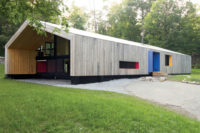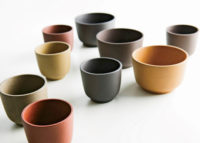As the principal of beijing-based DnA_Design and architecture, Xu Tiantian is one of the few women to head an architectural practice in China. Yet in many ways, the 34-year-old architect is typical of her generation of compatriot designers, conveying less interest in formal expressions of “Chineseness” than in finding inventive solutions for specific conditions — which happen to be in China. “ ‘Chineseness’ is too general a term,” says Xu, an alumna of Rem Koolhaas’s Office for Metropolitan Architecture. “I would rather our buildings be rooted in their given locations.
By deftly negotiating a building’s program and site, Xu has managed to build an impressive portfolio very early in her career. (Prolific building is another attribute she shares with many young Chinese architects.) Since founding her firm five years ago, Xu has completed projects ranging from a 29,000-square-foot art museum in Ordos, Inner Mongolia — its twisting form suggesting a desert viper — to a cluster of public toilets that sprout from the ground like periscopes at the Jinhua Architecture Park in Zhejiang Province, where artist and impresario Ai Weiwei invited 16 emerging and more established architects to design a series of small structures.
Trained at Beijing’s Tsinghua University and Harvard’s Graduate School of Design, Xu says architecture is about “the program and context influencing behavior and activities and interacting to define the building both inside and out.” It is a straightforward approach. But in Xu’s hands, it is often manifested as a meaningful complexity in which patterns of use maintain constant dialogue with the landscape. Consider Xu’s forthcoming town center for Baixi, a new resort area being built in the mountainous Changbaishan National Park near the North Korean border. Its main elements will include an entertainment hub of faceted, rocklike pavilions and a spa and aquatic center hovering above outdoor pools like an exploded bridge. A third element, a towering information center, will offer multiple views from its zigzagging ramps and platforms while evoking a directional signpost.
But Xu’s context remains China, and so her architectural narratives inevitably address aspects of the country’s sociopolitical condition. A design she has proposed for affordable workers’ housing in Beijing, for example, reconfigures the building type’s conventional layout of long, often dehumanizing rectangular blocks into compositions of overlapping, curvilinear volumes revealing open communal courtyards.
Meanwhile, on the outskirts of Beijing, her Songzhuang Artist Residences encourage both functional and metaphorical readings. Completed last year, its 20 units form a dynamic, random stack of 10- and 20-foot-tall concrete boxes housing, respectively, living and studio spaces. For Xu, the somewhat chaotic arrangement also responds to the area’s recent history as a refuge for artists, many of whom were evicted from their previous enclave near Beijing’s Old Summer Palace. “In such an artist community formed gradually after being expelled by the police, order and discipline have never been key characteristics,” she says. “Rather, violence and anger are more often expressed.”
The Songzhuang Artist Residences further demonstrates the improvisational approach often demanded by China’s tight budgets and even tighter construction schedules — a reality that “hardly allows time to devote to details,” Xu says. Working with a construction team of area villagers, Xu adapted the structure to suit local building techniques, while time and budget constraints required further compromises. “But that’s okay, because the project wasn’t about perfect details or beautiful materials, but creating this space for artists,” says Xu, whose forthcoming projects include an aquatic center for Dalian’s Maritime University and a 54,000-square-foot commercial center in Tsingdao for the Chinese real estate giant Vanke. “This is what I would call very Chinese — the ability to really adapt to a situation,” she says.























Post a comment to this article
Report Abusive Comment